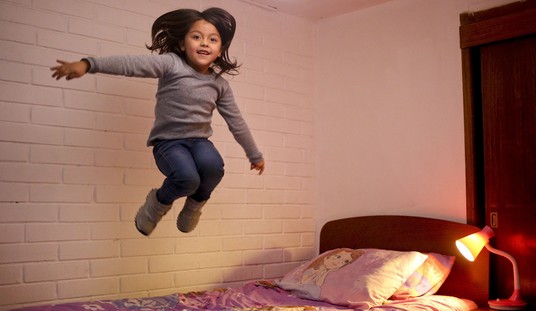The Boston Globe notices that the Democrats have a problem:
[A] Globe analysis of voter registration data in swing states reveals scant evidence that the massive undertaking [of Democratic voter registration drives] is yielding much fresh support for Obama.
In stark contrast to 2008, when a strong partisan tailwind propelled Democratic voter registration to record levels, this year Republican and independent gains are far outpacing those of Democrats.
In Florida, Iowa, North Carolina, Colorado, and Nevada – tossup states where direct election-year comparisons could be drawn – the numbers are striking. Democratic rolls increased by only 39,580, less than one-tenth the amount at the comparable point in the 2008 election.
At the same time, GOP registration has jumped by 145,085, or more than double for the same time four years ago. Independent registration has shown an even stronger surge, to 229,500, almost three times the number at this point in 2008.
…This week, Third Way, a centrist Democratic think tank, released a study of eight battleground states that illustrated the rise in independent voters since the 2008 election. The report, titled “The I’s Have it,” found that based on recent data, Democratic registration has declined by more than 800,000, or 5.2 percent; Republican enrollments were down about 80,000, or 0.7 percent; and independents were up 486,677, or 6.4 percent, in those states.
Read the whole thing for some of the dramatic results from Iowa and New Hampshire – sites of hotly contested GOP presidential primaries – in particular. The Democrats have an explanation for this, but it doesn’t address one of their core problems.
Here’s what the Democrats argue:
“The fact is, there are currently many more Democrats registered in battleground states now than there were before the 2008 primary campaign began, which means there are fewer eligible voters left to register because of the gains we made in 2008,” campaign spokesman Adam Fetcher said in an e-mail.
“We have largely preserved the huge gains we built in 2007 and 2008 and increased our advantage in some areas…”
Now, as a matter of logic and basic statistics, it’s true that when you pick a lot of the low-hanging fruit in one year, the ceiling on your rate of growth the next time around will be a lot lower. In some groups, like African-American adults (ie, born before 1987), this is undoubtedly a partial explanation.
But it also misses a basic dynamic regarding the Democrats’ coalition. The Democrats in general, and Obama in particular, rely on winning college-age voters by large margins. According to the NY Times exit polls, in the past 4 elections, Democrats carried the 18-29 year old vote 53-34 (Clinton vs Dole), 48-46 (Gore vs Bush), 54-45 (Kerry vs Bush) and 66-32 (Obama vs McCain). In the same four elections, Democrats won first-time voters 54-34, 52-43, 53-45 and 69-30. CNN’s exit polls had Obama winning voters age 18-24 (10% of the electorate) by 66-32 and 25-29 (8%) by 66-31, while McCain won a slight majority among the 64% of the voters age 40 and over. (The gap was especially pronounced among white voters, who went for Obama 54-44 in the under-30 age cohort but which McCain won by some 17 points among white voters over 30). Both sets of exit polls pegged new voters at 11% of the 2008 electorate.
Here’s the thing about voters age 18-21: there is 100% turnover among the group in each presidential election. Voters age 18-21 in 2008 were born between 1987 and 1990. Many of them were college students who probably registered at either their college address or their parents’ home. Most are now out of college, and may have moved away from home; in a fairly sizeable number of cases, those voters will need to update their registrations or re-register, or they are lost to the Democrats. Even if they do re-register, Democrats will need to be updating their databases to do GOTV efforts. Chasing young voters costs money that needs to be re-spent every cycle. The core Republican vote of adult homeowners with jobs and families does not present this problem.
By contrast, voters who are age 18-21 this year were born between 1991 and 1994, and – to put a fine point on it – not one of them was registered in 2008. If Democrats are not showing a large volume of voter registration, they are failing to register young voters who will be direly needed to win this election. This is aside from the fact that there has also been an unusual amount of voter dislocation since 2008 due to the economy – homes foreclosed, people moving to look for work. That can affect both parties, but it suggests some caution in Democrats relying on just maintaining their 2008 voter rolls.
This may prove particularly important because turnout will be so critical to this year’s election, perhaps even moreso than in 2004. If you read the polls, you have to be struck by the wide gaps between the polls of registered voters or all adults, those that attempt to model the election to resemble the 2008 turnout, or those that assume the electorate will look something like a cross between the 2008 and 2010 electorates. I don’t doubt that most of the pollsters are honestly reporting the results they are getting, but they diverge when they apply their as-much-art-as-science judgments to who is actually going to vote.
In the end, nobody knows for sure just yet. And even the voter registration picture may look a lot brighter for Democrats when college students return to campus in the fall. But the registration picture painted by the Globe is inarguably bad news for them as it stands right now.













Join the conversation as a VIP Member